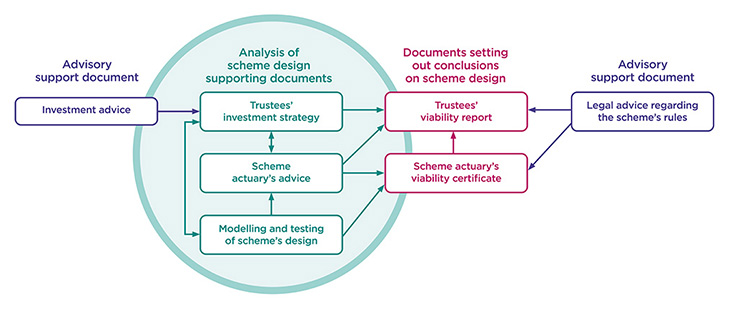CDC code in force: 1 August 2022
A scheme must have a sound scheme designSU1. The trustees’ explanation of this must be set out in the viability report, accompanied by a viability certificate, and should be supported by appropriate advice from suitably qualified professionals, as well as modelling and testing in line with a scheme’s complexity. Evidence of sound design will include, but is not limited to, evidence that the viability certificate tests are met and the reasoning and justification that support the conclusions made.
We will decide whether we are satisfied that the design of a CDC scheme is sound by taking account of the following mattersSU2:
- the information and documents listed below
- whether the scheme is a CDC scheme
- whether the scheme rules meet the legislative requirements on calculation of benefits
- whether the conclusions reached by the trustees and the scheme actuary as set out in in the viability report are justified
- whether the conclusions reached by the scheme actuary as set out in in the viability certificate are justified
- whether the contents of the viability report are sufficiently comprehensive
- whether the contents of the viability certificate are sufficiently comprehensive
- whether the information provided to us about testing or modelling is sufficiently comprehensive
Viability report, viability certificate, and connected information and documents
The trustees must prepare a viability report explaining the design of the scheme and the reasons they consider the design to be soundSU3. It must be prepared for an authorisation application and must be reviewed at least once a year and revised if necessarySU4.
The viability report must be submitted to us with the following:
- The scheme actuary's report as required by regulation 10(3)(b) including an explanation of their conclusions on the viability certificate tests, the assumptions used in carrying out these tests and how the use of these assumptions are justified, and the testing or modelling regarding the scheme's design being considered by the trustees.
- The trustees' strategy for investing the assets of the scheme: we expect to see evidence that this has been developed on the advice of an appropriately qualified and experienced professional.
- Extracts of the scheme rules concerning how the rate or amount of benefits provided under the scheme is to be determined. The relevant extracts are those relied on in the explanations in the viability report of the scheme's design and how the trustees are satisfied that the rules meet the relevant legislative requirements. These extracts can be included in the viability report or set out in an accompanying document to make the viability report more readable.
The trustees must also obtain a viability certificate in relation to the initial viability reportSU5 and at least annually thereafterSU6. While the viability report sets out the trustees' explanation of why they consider the scheme design to be sound, the viability certificate provides the scheme actuary's statement confirming that, in their opinion, the scheme design is sound.
The trustees and the scheme actuary will likely be basing their judgement on the same information: the testing and modelling carried out, the results of the viability certificate tests, the strategy for achieving sufficient investment returns to provide the target benefits, and how the assumptions used are justified, as well as the legal advice on whether the rules of the scheme meet the relevant legislative requirements.
We expect the above conclusions to be justified through appropriate evidence, including modelling and testing appropriate to the complexity of the scheme or sections. We will consider conclusions to be justified when they are supported by sufficient and comprehensive evidence and advice from qualified and experienced persons. What is comprehensive depends partly on the complexity of the scheme and its design, but the evidence and advice should meet professional standards and should address the issues outlined below in a way that allows the trustees to make clear decisions about their scheme. This will include an understanding of the downside risk and the likelihood of cuts to benefits, as well as the level of variation in benefits.
Figure 2: scheme design documents
Read a transcript of Figure 2: scheme design documents.
Legal references
SU1 Section 9(3)(b) of the Act
SU2 Section 12(2) of the Act and Paragraph 1 of Schedule 2 to the Regulations
SU3 Section 13(1)(a) of the Act
SU4 Sections 13(4)(a) and (b) and 5(a) of the Act
SU5 Section 13(1)(b) of the Act
SU6 Sections 13(4)(c) and (5)(b) of the Act


